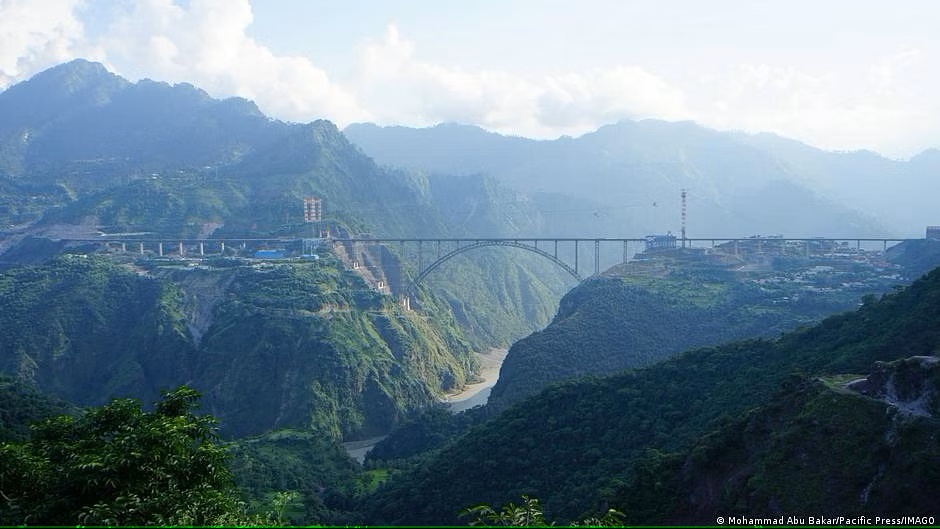Kashmir Now Home To World’s Highest Railway Bridge
May 19, 2023 | Pratirodh Bureau
A representative image of Kashmir (Photo: DW)
Source: DW
The world’s highest railway bridge is expected to open soon in India-administered Kashmir — connecting the remote Himalayan region with India’s vast railway network.
The bridge will dominate over the Chenab River at 359 meters (1,177 ft) high and 1,315 meters long. Constructed at a cost of $168 million (€156 million), the railway bridge is 35 meters taller than the Eiffel Tower.
The bridge is part of India’s ambitious 272-kilometer-long (169 miles) Udhampur-Srinagar-Baramulla rail link project (USBRL), with construction work starting more than two decades ago.
The arch bridge across the Chenab River is built in an area prone to high seismic activity, rough terrain, and hostile weather conditions. But engineers say the bridge is strong enough to withstand an earthquake of up to eight on the richter scale, and is expected to have a lifespan of 120 years.
Indian Prime Minister Narendra Modi praised the bridge as a “growing prowess of India in the field of modern engineering and technology.”
The ruling BJP government also considers the bridge crucial to bringing further development to the region under direct federal rule.
Indian federal Railway Minister Ashwini Vaishnaw called it a strategic project.
“Connecting Jammu and Kashmir through rail is one of the toughest engineering challenges in the world,” he said, adding that the railway network to Kashmir will be completed later this year or early next year.
‘One of the toughest engineering challenges in the world’
An official involved in the project, who requested anonymity, told DW 28,000 tons of steel has been used in the construction of the bridge between the mountainous villages in the Reasi district in the southernmost part of Jammu.
The railway line, which mobilized thousands of construction workers and engineers, has already missed multiple deadlines.
“This was not an easy thing. We had to continuously struggle with the harsh terrain,” an engineer who worked on the project told DW, requesting anonymity. “This whole area is sensitive and comes under the highly seismic zone,” they added.
According to the engineer, trial runs and speed tests are being conducted.
The biggest challenge is linking Katra in Jammu to Banihal in Ramban district, which consists of deep river gorges and rocky terrain.Fears of landslides and harsh weather make it challenging for its construction. But accomplishing construction for this stretch would finally connect the region with India’s expansive railway network.
A Game-Changer For Tourism
Muhammad Unis, a travel operator in Srinagar, told DW that the railway line will act as a game changer for tourism in the region.
“This will reduce the travel costs and bring ease of access to the region for tourists,” he said.
Being one of the most highly militarized zones in the world, the connectivity is also expected to help with the mobilization of troops and logistics to the region.
With the Indian army already facing a protracted standoff with the Chinese military along both the nations’ contested border in eastern Ladakh, the uninterrupted mobilization of troops and equipment could bring major relief.
The railway connectivity also offers people an alternative to the mountainous Srinagar-Jammu highway — a key road connecting Kashmir with other states.
The highway is often blocked in the winter and prone to landslides which cause fatal accidents.
Local Concerns
Despite the benefits, some locals have apprehensions about the bridge.
“We fear that there might be more rush from non-locals to the ecologically fragile region,” Maroofa Nisar, a local private school teacher, told DW.
The 2019 abrogation of Article 370, which granted a special constitutional status to the region, and other measures by the BJP government, have granted more rights to non-locals to start businesses and buy property in Kashmir — rights that were once reserved for permanent residents only.
According to official records, 185 non-locals have bought land and 1,559 companies have invested in the region so far.
Sheikh Showkat Hussain, a political analyst based in the region, told DW that “the train will reduce the physical distance, but not the psychological barriers.”
“The infrastructure reduces physical distances but not the trust deficit and the feeling of being subjugated.”
